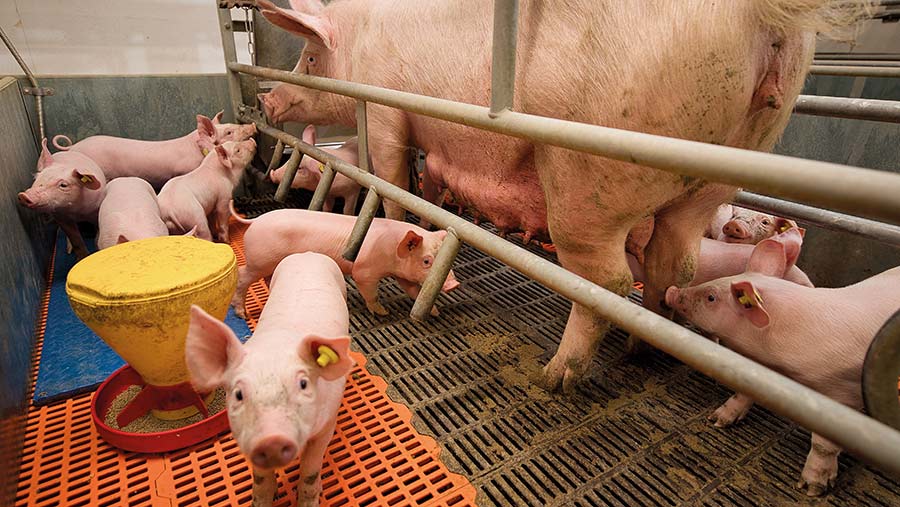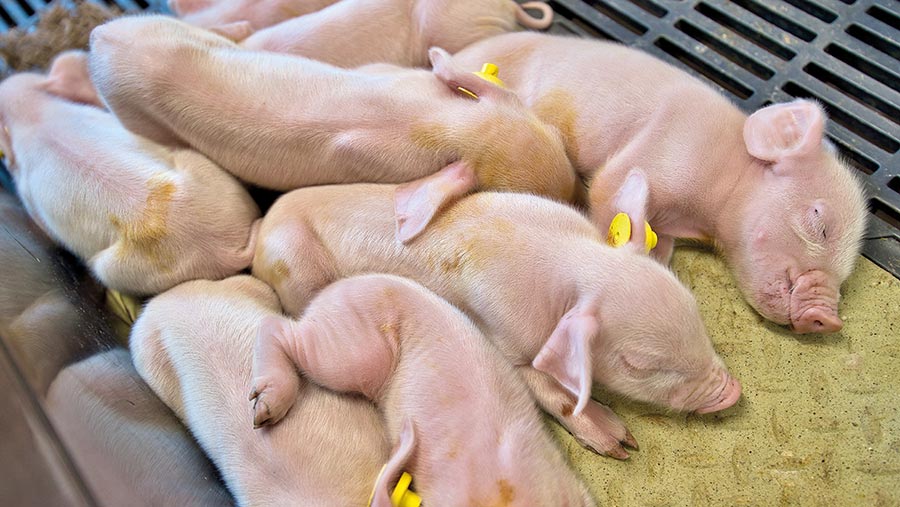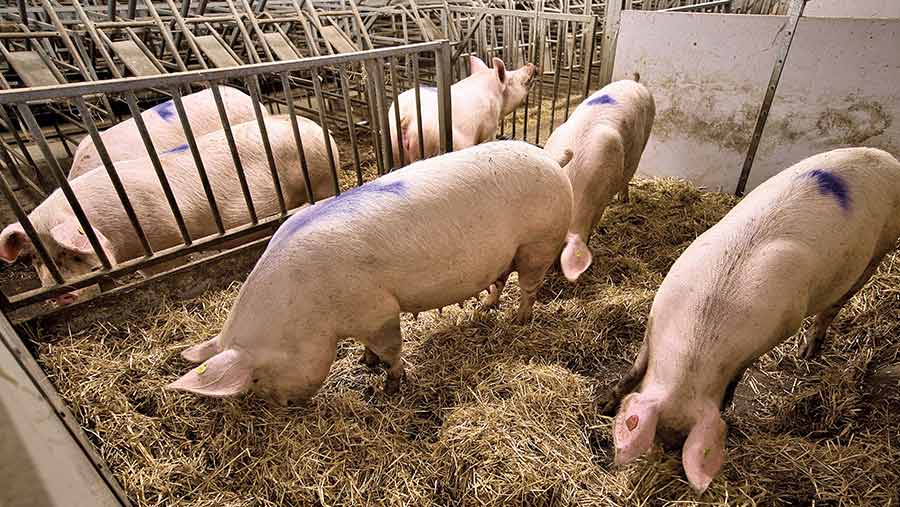6 ways pig unit works with minimal zinc and antibiotics use
 © Richard Stanton
© Richard Stanton Ensuring good gut health in piglets pre- and post-weaning is the foundation for lifetime health and performance on Harper Adams University’s 230-sow farrow-to-finish unit.
The unit, which operates as a commercially independent enterprise and a teaching and research facility, has not used medicinal levels of zinc oxide at weaning for many years. Antibiotics use is also minimal, at 5.1mg/kg for the past quarter.
The practice of using zinc oxide is set to be banned next summer in the UK and EU.
At Harper, the philosophy is prevention rather than cure, with good hygiene, biosecurity, nutrition and gut health proving more cost-effective than antibiotics and other medicines.
See also: 5 zinc oxide alternatives for pigs compared
Sarah Icely, the unit’s research assistant, emphasises that getting the basics right consistently is key to good pig health and performance. Below, she explains what steps the unit takes to achieve this.
1. Cleaning and drying
The unit follows a well-established routine cleaning and resting protocol in the farrowing house, weaner and finisher accommodation before each new batch of pigs is introduced.
“Thorough cleaning and disinfection form the basis for the unit’s health management, particularly gut health, which has positive knock-on effects for performance,” Mrs Icely says.
“We want to get piglets off on the right foot from birth and maintain strong, healthy animals through to finishing. The team takes pride in getting cleaning and disinfection right every time.”

Sarah Icely says shed hygiene has a knock-on effect on gut health and performance © Richard Stanton
Thorough drying is vital, she adds. At least one week is allowed in between batches at each stage of production, for cleaning, disinfecting and drying, to avoid pigs moving into a damp environment.
Pens and equipment are first soaked and washed with detergent, then allowed to dry before disinfectant is applied, so it doesn’t just run off wet surfaces. This is then allowed to dry again before the next batch of pigs comes in.
2. Sow management
The first focus is on weaning a strong piglet. Management of the sow is key to achieving this.
Sows are fed a high-specification lactation diet to make sure they milk as well as possible for the piglet and maintain their own condition ready for the next service. They start at 4kg a day and this is increased by 1kg each day until day 14 of lactation.
Sows are fed twice daily, and in the last two weeks they are fed ad-lib, with intakes reaching about 15kg a day.
The team counts the number of functioning teats at each farrowing and when selecting replacement gilts, which are bred in the unit. This is an important factor in maintaining herd biosecurity.
The target is to wean 14 piglets a sow, so gilts require at least that many teats. Numbers born alive are currently averaging 16 a litter with 13.8 piglets weaned a sow.
Weaning weight is averaging a healthy 8.5kg at 26 days.
3. Farrowing house management
Making sure all newborn piglets get enough colostrum is essential to provide enough energy and transfer passive immunity from the sow to the piglet.
“We have large litters born, including some very small piglets,” Mrs Icely says. “Sows are milked into a bottle, where needed, so that piglets can be fed by hand and we give a booster paste to any piglet weighing less than a kilo.”
Litters of more than 14 piglets are split suckled, with the biggest half of the litter separated into a bucket for one hour to allow the smallest half to feed. This is done twice in the first 24 hours after birth.
Piglets also have a heat mat for additional warmth and stress is kept to a minimum, with no tail docking on the unit and vaccination delivered via sows.

© Richard Stanton
For the past 15 years, all piglets have had access to supplementary milk from birth until a few days before weaning.
Sow milk yield is typically insufficient for the piglets’ appetite from day 21 of lactation and the supplementary milk helps fill the gap, particularly in larger litters.
“Our trial work has shown that all pigs use the supplementary milk bowls and litter weights are higher and less variable with more even piglets weaned,” says Mrs Icely. “I’m currently working to identify which piglets are benefiting the most from supplementary feeding as part of my PhD.”
4. Creep feeding
Piglets are offered creep from two weeks old, starting with a softer, highly-palatable pellet to help get them interested. To begin with, just a handful of creep is provided in round trays attached to the slats, to make sure it remains fresh.
By the end of lactation, each litter can eat about 2kg/day, according to demand.
During the last week in the farrowing house, piglets are fed the post-weaning diet to ease the transition over the weaning period.
“Gut maturity is our main aim with creep feeding, as we’re looking to develop the structure of the gut and its microflora,” Mrs Icely explains.
“There is a growing focus in the industry on the balance between beneficial lactic acid-producing bacteria and pathogens in the pig’s gut,” she says. “A strong population of beneficial bacteria makes the conditions unfavourable for pathogenic ones.”
In situations where antibiotics must be used, beneficial gut bacteria can also be diminished along with the disease-causing organisms. It takes time for the gut microflora to build back up again, so growth rates may become checked in the meantime.
“The real effects of different creep diets on growth are seen in the finisher period,” she adds.
She says piglets provided with the optimum creep diet are 2kg heavier on average at slaughter, having capitalised on a healthy gut development in early life.
Pigs are given two starter feeds and a link diet before moving on to a grower diet at two and a half weeks post-weaning.
The average age at slaughter is 152 days at 115kg, while the overall average daily liveweight gain from weaning to slaughter is 860g a day. Finishers average 1.06kg a day between 40kg and slaughter.
5. Weaned pig management
In the weaner pens, there are enough feeder spaces for all piglets to eat at the same time, which helps minimise the stress of being weaned from the sow into a new environment.
Even so, growth rates can halve in the week following weaning.
Litters are mixed at weaning, but this doesn’t seem to cause any major issues.

© Richard Stanton
6. Healthy pigs
There are no problems with scour after weaning and only occasionally in the farrowing room, but there is rarely a need to medicate for scour.
Antibiotics usage is now very close to zero and has been used only to treat a couple of incidences of Glassers in the past two years.
Sows are vaccinated for E coli, erysipelas and parvovirus, while piglets are vaccinated at weaning against circovirus and enzootic pneumonia (EP).
“We don’t have EP in the herd but vaccinate to help make sure it stays that way, as we are in quite a pig-dense area,” Mrs Icely says.
Farm facts
- 230-sow indoor farrow-to-finish unit
- Closed herd, breeding own replacements
- Team of five, covering pig management as well as teaching support and trial data collection

